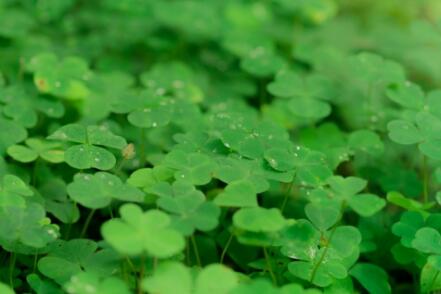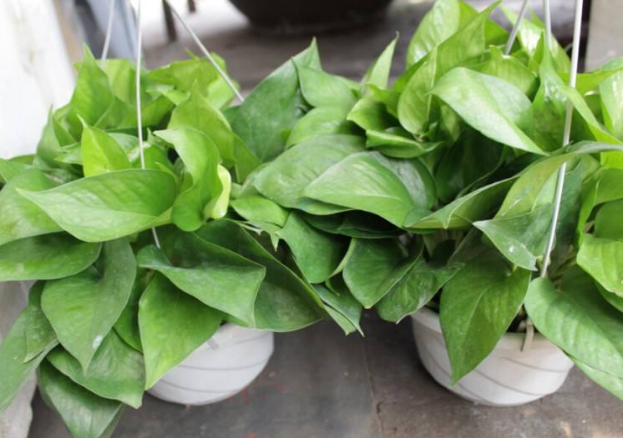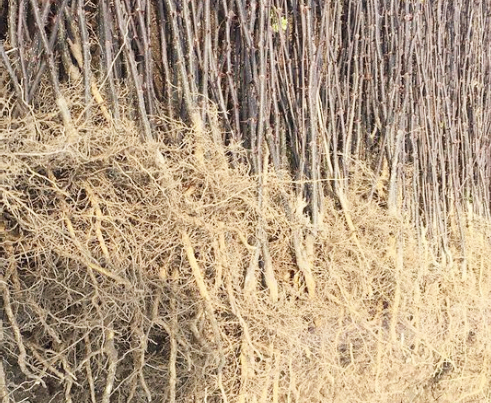When will the clover be sown? What is the balcony planting method?
Clover, also known as white clover, white clover, Holland warpage, it has three leaves, some mutants have four leaves, or five leaves. Clover is a very common garden quilt, which is common in courtyards, road greening and parks. It is liked by many people because of its small and exquisite appearance and special leaf shape. When will the clover be sown? What is the balcony planting method?

1. Morphological characteristics of clover.
The main root of clover is short, the lateral root is developed, and there are nodules for nitrogen fixation. Stolon long 30~60cm, solid smooth, can take root, sprouting new buds to grow into a new stolon, very invasive. If properly managed, it can grow continuously for more than 7 years. Palmately Ternate compound leaves, petiole slender, leaves with "V"-shaped white markings. It has good shade resistance and can grow normally under the environment of 30% light transmittance.
Clover has more developed lateral root and stolon, which is more competitive than other weeds. Clover blossoms early, florescence is long, leaf shape is beautiful, and good landscape effect can be obtained after flat formation. Like warm and humid climate, the optimum temperature for growth is 1525 ℃, and the suitable annual precipitation for growth is 600~850mm. Clover is more tolerant to shade and cold, and is sensitive to drought. When the temperature is more than 38 ℃, the stems and leaves wither and even die. The soil is not strict and has strong acid resistance. it can also grow on the soil with pH 4.5 and can grow in many parts of our country.
When will the clover be sown?
Clover can be sowed in spring or autumn, spring in late March, autumn in mid-September, autumn sowing in the south, spring sowing in the north, and sowing in summer, but the topsoil must be moist or shaded with mulch after sowing. The suitable sowing rate of clover is 8 grams per square meter, and there are 1400 and 2000 seeds per gram of clover. Theoretically, one seed per square centimeter of soil can meet the needs of forming a flat, and the actual sowing rate is larger than the theoretical sowing amount.
Third, the planting method of clover balcony
1. Soil requirements
The requirement of soil is not strict, it can adapt to various soil types, and grow well in acidic soil. Because of the small seeds, the soil in the flowerpot needs to be leveled into fine soil.
2. Sowing seeds
Time: the best sowing time of clover is in spring and autumn. Spring sowing can be from the end of March to the end of April. When the air temperature is more than 15 ℃, it can be sowed. Autumn sowing usually starts from the middle to late September.
The seeds of clover need to be soaked before sowing, add water 1.5kg per 1kg seed, add 1g ammonium molybdate to soak seeds for 12 hours, mix fine soil with calcium magnesium phosphate fertilizer 5-10kg or yellow sand 5-10kg, and sow seeds. Seedlings can be seen about 3 days after sowing.
Sowing method:
First put the soil into a cup about 70% full, then put in about 20 seeds, then cover and water with soil; water the soil once a day to ensure that the soil is moist; when the seedlings are growing up, do not spray water with a kettle, nor should they be exposed to the sun. Just put it in a sunny room.
3. Temperature
Clover likes the environmental conditions of warm, sunny, good drainage and humid climate. The suitable temperature for growth is 19: 24 ℃. Strong moisture resistance, can withstand more than 1 month of stagnant water, shade resistance.
4. Fertilization
Clover belongs to legume, which has the ability of nitrogen fixation, but the rhizobium has not been formed at seedling stage, so a small amount of nitrogen fertilizer should be added to strengthen seedlings, and the application of phosphorus and potassium fertilizer can increase yield. When the clover grows up, it only needs to supplement phosphorus and potash fertilizer.
5. Diseases and insect pests
There are few diseases of clover, but the harvest is not timely, and sometimes brown spot and powdery mildew occur, which can be cut and used first, and then controlled by Bordeaux solution, stone-sulfur mixture or carbendazim.
Time: 2019-03-13 Click:
- Prev

The maintenance method of "flower of life" green apple, do a good job of these four points, easily burst the basin!
Green pineapple is one of the most popular green plants on the market, no matter at home or in the office, everyone likes to put a pot on it. The daily maintenance of green pineapple is very simple and its vitality is tenacious. Basically, as long as there is water, you can live, but if you raise it well, you still need to take good care of it. Here's how to maintain the green pineapple, the flower of life.
- Next

How much is a prickly ash sapling? What are the planting prospects and profits?
When it comes to Zanthoxylum bungeanum tree, we should be very familiar with it. Usually, we often use it for seasoning when we cook. Because it has certain medicinal value, strong adaptability and wide distribution, it is very popular among people. Many growers also want to plant it to make their families rich. So how much is a pepper sapling?
Related
- Fuxing push coffee new agricultural production and marketing class: lack of small-scale processing plants
- Jujube rice field leisure farm deep ploughing Yilan for five years to create a space for organic food and play
- Nongyu Farm-A trial of organic papaya for brave women with advanced technology
- Four points for attention in the prevention and control of diseases and insect pests of edible fungi
- How to add nutrient solution to Edible Fungi
- Is there any good way to control edible fungus mites?
- Open Inoculation Technology of Edible Fungi
- Is there any clever way to use fertilizer for edible fungus in winter?
- What agents are used to kill the pathogens of edible fungi in the mushroom shed?
- Rapid drying of Edible Fungi

